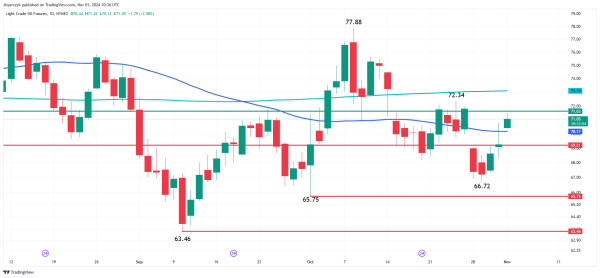Oil News: Crude Rallies as Iran-Israel Tensions Threaten Supply
Crude Oil Futures Surge with Renewed Middle East Risk Premium

Light crude oil futures traded sharply higher on Friday, breaking above the 50-day moving average of $70.17, a level that now acts as new support. This push higher turned the intermediate trend to an upward stance, and the next significant target is the 200-day moving average at $73.10, which marks the threshold for a long-term bullish trend. Prices are currently trading near the upper boundary of a retracement zone between $69.21 and $71.63, and surpassing this zone could trigger additional buying momentum.
At 10:40 GMT, Light Crude Oil futures are trading $70.94, up $1.68 or +2.43%.
Geopolitical Tensions Escalate with Potential Iran-Israel Conflict
The surge in oil prices comes as geopolitical tensions intensify following reports suggesting Iran may conduct retaliatory strikes on Israel. Citing Israeli intelligence, sources indicate that Iran is mobilizing drones and ballistic missiles in Iraq, with a potential attack anticipated before the U.S. presidential election on November 5. This increases the risk of further hostilities in the Middle East, as observed by SEB Research’s Ole Hvalbye, who noted the probability of an escalation that could disrupt oil markets. Although Israel and Iran have shown restraint in recent confrontations, any military escalation could drive oil prices further upward as traders account for possible supply disruptions.
OPEC+ May Delay Production Increases Amid Demand Uncertainty
Adding to bullish sentiment, expectations are growing that OPEC+ could delay its planned oil production hike, initially scheduled for December. Several OPEC+ sources report concerns about fragile oil demand and higher supply levels, suggesting the potential delay could be extended by a month or more. OPEC+ members could finalize this decision as early as next week, supporting current price levels as the market anticipates tightened supply.
Mixed Market Factors: Weekly Losses Despite Mid-East Risk
Despite Friday’s gains, oil prices are on course for a weekly decline of over 1%, stemming from a 6% drop earlier in the week after Israel’s October 26 strike on Iranian military assets left energy and nuclear infrastructure undisturbed. Both Iran and Israel have shown restraint, with retaliatory actions limited to demonstrations of strength rather than full-scale conflict, according to Hvalbye.
However, uncertainty ahead of the U.S. presidential election and the Chinese National People’s Congress (NPC) standing committee meeting next week may affect market sentiment, noted IG analyst Tony Sycamore, as shifts in U.S. policy on Iran and Russia remain possible depending on the election outcome.
China’s Manufacturing Recovery Adds Demand Optimism
In another supportive factor, China’s manufacturing sector showed signs of growth in October, driven by recent stimulus measures. Private-sector surveys revealed a return to expansion for the first time in six months, which aligns with data from official sources.
This resurgence suggests that the Chinese economy may support global oil demand in the coming months, although Goldman Sachs analysts caution that China’s growth will likely focus on internal consumption, given reduced infrastructure and housing construction activity.
Market Forecast: Bullish Bias on Rising Geopolitical Risks and Supply Constraints
With geopolitical risk premiums and potential supply adjustments by OPEC+, the near-term outlook for crude oil is bullish. Prices may push towards the 200-day moving average of $73.10 if Iran-Israel tensions escalate or if OPEC+ confirms production cuts next week.